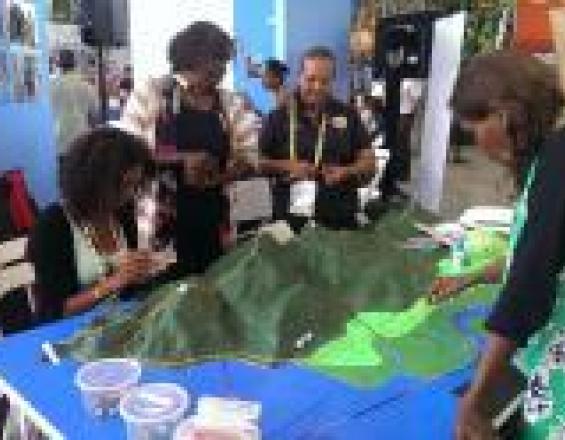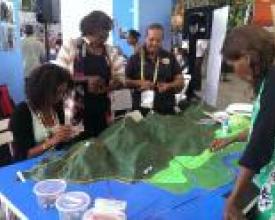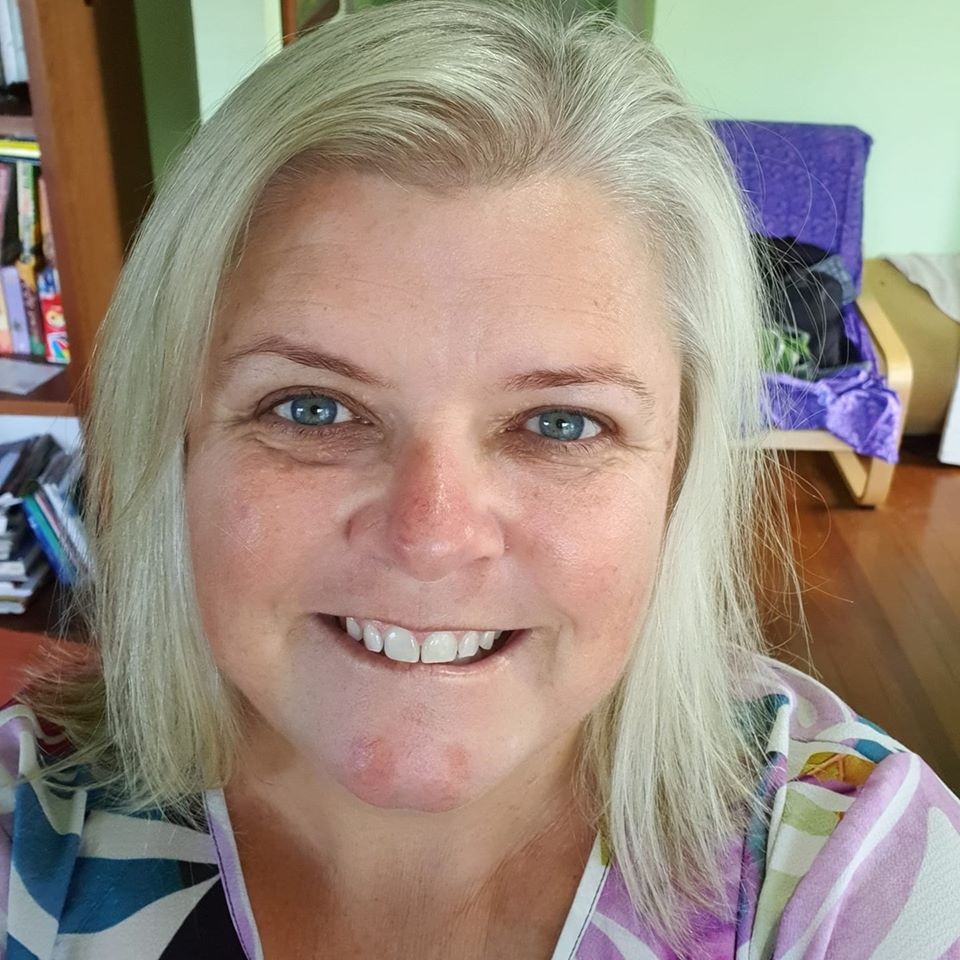Empoderamiento de la población Mandingalbay Yidinji a través de P3DM

El pueblo Mandingalbay Yidinji (MY) del Área del Patrimonio Mundial de los Trópicos Húmedos (Australia) ha utilizado la modelización tridimensional participativa (P3DM) para empoderar a su comunidad mediante la cartografía y el intercambio de conocimientos culturales y paisajísticos. El proyecto fue facilitado por la Autoridad de Gestión de los Trópicos Húmedos y contó con la participación de toda la comunidad MY. La toma de decisiones sobre qué mostrar y qué excluir corrió enteramente a cargo del pueblo MY.
Contexto
Défis à relever
Pérdida de información cultural en áreas protegidas Gran parte de la información cultural vital de las áreas protegidas se pierde cuando los poseedores de los conocimientos fallecen, son desconectados y/o cuando no pueden acceder a sitios culturales clave. Muchos métodos de cartografiar información culturalmente sensible son poco fiables y excesivamente técnicos. La P3DM capacita a los pueblos indígenas como impulsores del proceso.
Ubicación
Procesar
Resumen del proceso
Una P3DM es el resultado de un proceso bien facilitado con una verdadera participación en su núcleo. Cada componente se apoya en una base sólida creada durante los componentes anteriores. La capacidad del facilitador para mantener a los participantes implicados y centrados en la tarea proporcionó el aglutinante para la continuidad y generó la confianza de los participantes en el facilitador. La construcción del modelo "a escala" suscitó preguntas y curiosidad, lo que a su vez generó un interés continuo y una apropiación del producto "construido por la comunidad". El compromiso de los participantes con el proyecto aumentó en cada etapa sucesiva y a medida que "experimentaban" el valor del proceso. El P3DM no se limita a cartografiar el conocimiento, sino que se ha utilizado en todo el mundo para la planificación de áreas protegidas, el impacto del cambio climático, la resolución de conflictos, la cartografía de recursos, la gestión de la vida salvaje, el registro del patrimonio inmaterial, etc. El empoderamiento del pueblo Mandingalbay Yidinji a través del P3DM les infundirá una nueva confianza para ser los agentes del cambio dentro de su propio entorno.
Bloques de construcción
Identificación y selección de las comunidades
Factores facilitadores
Lección aprendida
Información a la comunidad y selección del emplazamiento
Factores facilitadores
Lección aprendida
Preparación técnica y SIG
Factores facilitadores
Lección aprendida
Crear y acordar la leyenda/clave del modelo
Factores facilitadores
Lección aprendida
Construcción del modelo
Factores facilitadores
Lección aprendida
Representación de los conocimientos en el modelo
Factores facilitadores
Lección aprendida
Impactos
El proyecto P3DM, emprendido en octubre de 2014, ya ha producido impactos y cambios. Se oyó decir a un miembro de la comunidad MY "... hacer esto me ha vuelto a conectar con mi país, con mi paisaje, no me lo esperaba...". Este proyecto reunió a la comunidad para centrarse en algo positivo y participar en un proceso en el que los MY podían controlar los resultados, algo poco frecuente entre los pueblos indígenas australianos. El proceso P3DM también ha empezado a reconectar a los jóvenes que se habían desconectado de la cultura y el paisaje: se han interesado por lo que tienen que decir los miembros de más edad de la comunidad y han empezado a ver cuánto conocimiento cultural queda en MIS mayores.
El proyecto P3DM ya ha animado a la gente de MY a utilizar el modelo para planificar actividades de desarrollo económico en sus tierras tradicionales con el fin de crear medios de vida más sostenibles. Otro impacto es la inspiración que este proyecto ha creado en otros aborígenes para que aprendan y utilicen ellos mismos el P3DM. Lo ideal sería que MY estuviera al frente de la facilitación de futuras actividades de P3DM con otras comunidades aborígenes. Esto ayudará a ampliar, fortalecer y profundizar el impacto.
Beneficiarios
Pueblo aborigen Mandingalbay Yidinji y Autoridad de Gestión de los Trópicos Húmedos.
Objetivos de Desarrollo Sostenible
Historia
En noviembre de 2014, seis representantes de Mandingalbay Yidinji participaron en el VI Congreso Mundial de Parques celebrado en Sídney (Australia). Durante la fase de construcción, la comunidad desarrolló un "espacio en blanco" adicional de 2 m x 1 m que se transportó por carretera a Sídney. Los representantes de MY pasaron de 3 a 4 días haciendo una demostración en vivo en el Congreso representando lentamente sus conocimientos utilizando pintura, alfileres y hebras de lana, sobre el espacio en blanco. Además de la información sobre el patrimonio cultural, también trazaron límites como la zona del Patrimonio Mundial de los Trópicos Húmedos y la zona indígena protegida de Mandingalbay Yidinji. Esta demostración en directo, celebrada en el Pabellón de la WIN y las Comunidades del Pacífico, atrajo mucha atención y un interés genuino por parte de delegados de todo el mundo. El trabajo realizado por la gente de MY creó una excitante expectación en el pabellón y atrajo a la gente a hacer preguntas sobre el proceso y sobre mi país tradicional. Más de 250 delegados dejaron sus tarjetas de visita en la demostración, solicitando más información sobre P3DM. La demostración formaba parte de una serie más amplia de congresos sobre P3DM coordinados por el Centro Técnico de Cooperación Agrícola y Rural (CTA). El CTA también coordinó la asistencia de profesionales del P3DM de Kenia, Chad, Surinam, Samoa, Etiopía, Trinidad y PNG. Conocer y compartir experiencias con otros profesionales indígenas de la P3DM y conversar con delegados de todo el mundo ayudó a la gente de MY a comprender la importancia de su propia experiencia en un contexto global. La experiencia de la CMP aumentó la confianza de los delegados de MY y su convencimiento de que la P3DM es una técnica muy valiosa. En una sesión del Congreso sobre los riesgos y beneficios de cartografiar los conocimientos tradicionales, la gente de MY presentó el modelo completado al Congreso y habló de sus experiencias durante el proceso y como aborígenes de la selva tropical. El campeón del Congreso, Luvuyo Mandela, asistió a la presentación y, en un emotivo discurso, afirmó: "Nosotros, como pueblos indígenas, necesitamos aprender un lenguaje que nos ayude a comunicar lo que necesitamos y quiénes somos de una forma que sea digerible para el resto de la comunidad. Esta iniciativa es increíble".



